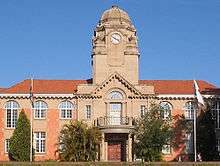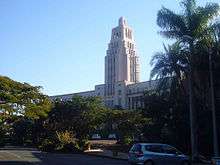University of Natal
 The main clock tower of Old Main Building, located on the Pietermaritzburg campus | |
| Latin: Universitas Nataliensis | |
Former names | Natal University College (1910 - 1949)[1] |
|---|---|
| Motto | Stella Aurorae |
Motto in English | Star of the morning |
| Type | public |
| Active | 1949[1]–2003 |
| Location | Durban & Pietermaritzburg, KwaZulu Natal, South Africa |
| Current status | On 1 January 2004 the University of Natal as a distinct legal entity ceased to exist.[2] It was incorporated on the above date into a new legal entity which is called the University of KwaZulu-Natal.[2] The University of Natal was regulated by the University of Natal Act 7 of 1960. |
| Colours | Black, blue, green |
The University of Natal was a university in Natal, and later KwaZulu-Natal in South Africa. The University of Natal no longer exists as a distinct legal entity as it was incorporated into the University of KwaZulu-Natal on 1 January 2004.[2] It was founded in 1910 as the Natal University College in Pietermaritzburg, and expanded to include a campus in Durban in 1931. In 1947, the university opened a medical school for non-white students in Durban. The Pietermaritzburg campus was known for its agricultural engineering programmes, hence the nickname "the farmers" whilst the Durban campus was known as "the engineers" as it concentrated on other engineering programmes.
Brenda Gourley, a qualified Chartered Accountant, was the second last Vice-Chancellor of the University of Natal. Her appointment at the University in 1994 was an historical event in South Africa. She was the first woman in South Africa to be appointed as a Vice-Chancellor of a South African University.
The Maritime law programme based at the then Institute of Maritime Law at the University of Natal, which was pioneered under the headship of Professor Hilton Staniland, was one of the first Maritime law programmes of its kind in South Africa. The above Institute was well known in South African Maritime circles. A number of South African statutes regulating the South African maritime industry were drafted by Professor Hilton Staniland at the above Institute, including the Carriage of Goods by Sea Act 1 of 1986 and the Wreck and Salvage Act 94 of 1996.[3]
The main science block on the Howard College campus, completed in the early 1980s, was a pivotal location for biological research and game conservation for the province.

The Howard College campus in Durban was strung out along the Berea, a ridge to the north of the Durban city centre.
Under apartheid, the Durban campus of the university was known for the activism of its staff and students against government-imposed racial segregation. In the 1970s and 1980s many of its students were members of the often-banned National Union of South African Students (NUSAS), centred on the main arts centre at the Howard College campus. In addition, the university magazine Dome (named for the dome of Howard College), was active against apartheid and was often banned, with the printing press being moved around to prevent its being confiscated by police. In 1980 there was a brief boycotting of the food hall by the college residences because of the unfair treatment of black staff by the food supply contractor FEDICS.
The Durban campus had a number of onsite residences, named after prominent South Africans including Ernest Jansen, Louis Botha and Mabel Palmer.
Pietermartizburg campus was the original campus, though it later became the smaller of the two main campuses. The campus is in a suburban location, centred on the library and administration buildings. The library houses many historic books, including books on colonial history and Boer war history. Unlike the Durban campus, most students did not live in campus residences.
On 1 January 2004, the University of Natal was merged with the University of Durban-Westville to create a new legal entity called the University of KwaZulu-Natal.[2]
Alumni
- For full list, see Category:University of Natal alumni
References
- 1 2 Guest, Bill (2009). "Stella Aurorae: Establishing KwaZulu-Natal's First University" (PDF). Natalia. Natal Society Foundation (39): 65–78. Retrieved 12 October 2012.
- 1 2 3 4 "Statute of the University of KwaZulu-Natal (Proclamation number R.684, 2006)" (pdf), Government Gazette (29032:3), 14 July 2006, retrieved 31 Aug 2014
- ↑ "Professor Hilton Staniland". Institute of Maritime Law. University of Southampton. Retrieved 2014-08-31.
Coordinates: 29°52′05″S 30°58′50″E / 29.868038°S 30.980501°E